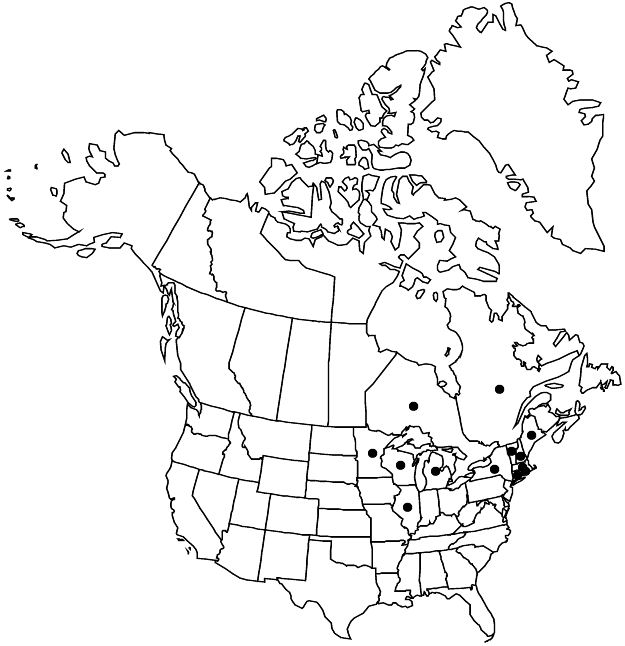Crataegus fluviatilis
Rhodora 5: 117. 1903.
Shrubs or trees, multistemmed, 30–40 (–70) dm. Stems: twigs: new growth golden green to strongly reddish tinged, sparsely pubescent or glabrous, 1-year old usually shiny, dark-brown, older gray; thorns on twigs 1-year old shiny, deep brown to blackish, often black-tipped, stout to slender, 2.5–5 cm. Leaves: petiole length 30–60% blade, sparsely to densely glandular; blade ovate, 3–6 cm, base subcordate, truncate, or rounded to cuneate, lobes 3–6 per side, sinuses shallow to moderately deep, lobe apex acute to acuminate, margins serrate, teeth numerous, small, larger ones conspicuously glandular, particularly at base, smaller ones inconspicuously gland-tipped, veins 4–6 per side, apex acute, adaxial surface densely appressed-scabrous-pubescent young, glabrescent. Inflorescences 5–12-flowered; branches pubescent; bracteoles usually absent (even young), sometimes few to several, often red-tinged, ± linear. Flowers 12–17 mm diam.; hypanthium glabrous; sepals 4–5 mm, margins subentire to weakly serrate, usually eglandular, abaxially glabrous or pubescent; stamens 5–10, anthers pink to reddish purple; styles 3–5. Pomes bright to deep red, suborbicular to ellipsoid, 8–15 mm diam.; sepals erose or erect-patent; pyrenes 3–5, dorsally shallowly grooved.
Phenology: Flowering May–Jun; fruiting Sep–Oct.
Habitat: Old fields, fencerows, brush, woodland margins, open woods
Elevation: 0–500 m
Distribution

Ont., Que., Conn., Ill., Maine, Mass., Mich., Minn., N.H., N.Y., R.I., Vt., Wis.
Discussion
Crataegus fluviatilis includes a range of intermediates between C. flabellata and C. macrosperma. There are three main forms. In the typical form, sporadic in Quebec and New England, the glandular-serration of the sepal margins is less pronounced and the inflorescence branches at anthesis are less densely hairy than in C. flabellata, but the leaves are more similar to those of C. macrosperma. They could represent rare hybrid derivatives of these two species. In the central Great Lakes region (Illinois to Ontario), more frequent forms occur attributable to C. apiomorpha, similar to sympatric C. macrosperma, differing mainly in their soft-hairy inflorescences. More complex variation occurs in Minnesota, where forms with densely pubescent inflorescences occur in local populations, often intermixed with otherwise identical C. macrosperma (glabrous inflorescences). Both the latter are notable for their serrate sepal margins, not the norm for C. macrosperma. Into the mix are identical forms with 20 stamens, which perhaps are C. asperata Sargent. This Minnesota complex is notable for smallish leaves (4–6 cm), is constant for characters other than those mentioned above, and suggests active introgression.
Confusion between the Minnesota form of Crataegus fluviatilis and sympatric C. chrysocarpa might be possible; a helpful field character at anthesis is the pink anthers of the former; at other times, it is the flexible petioles that allow the leaves of C. fluviatilis to flutter in the wind, unlike those of C. chrysocarpa, which have stiffer petioles.
Selected References
None.
Lower Taxa
"thin" is not a number."glandular" is not a number."adnate" is not a number."dm" is not declared as a valid unit of measurement for this property.